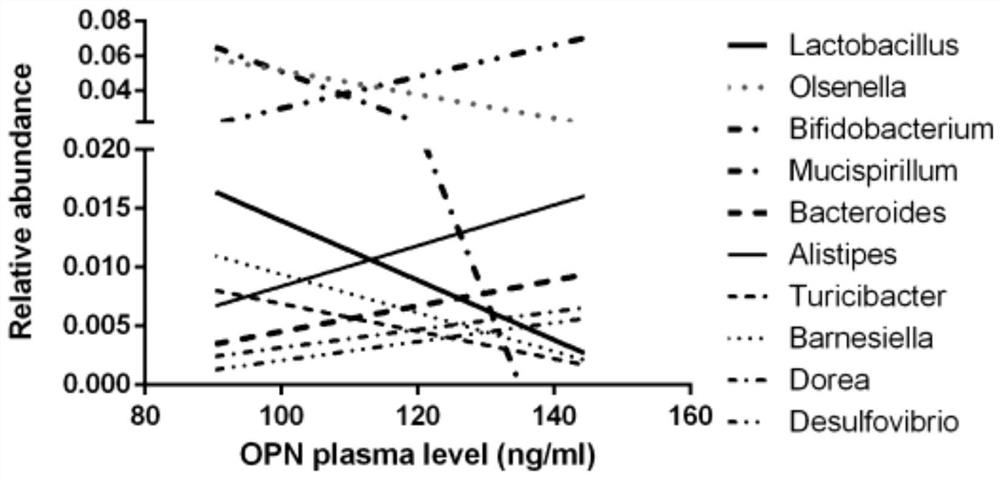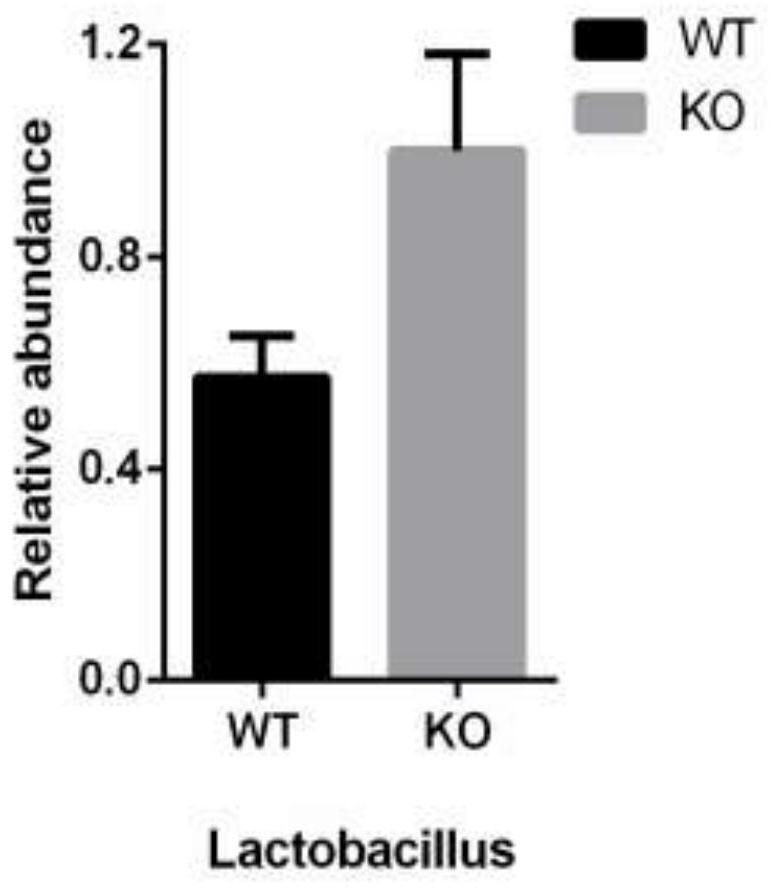Application of osteopontin as a target molecule in regulating intestinal flora colonization
A technology for regulating intestinal flora and osteopontin, which is applied in the fields of analytical materials, biomaterial analysis, microbial measurement/inspection, etc., to achieve the effect of enhancing adhesion and improving expression
- Summary
- Abstract
- Description
- Claims
- Application Information
AI Technical Summary
Problems solved by technology
Method used
Image
Examples
Embodiment 1
[0023] Example 1: OPN can affect the colonization of bacterial flora in the intestinal tract of mice
[0024] Eighteen 4-week-old C57BL / 6 mice were selected and fed under the same diet for 24 weeks to determine the content of OPN in the plasma of the mice, and 16S rRNA sequencing was performed on the ileocecal mucosal flora of the mice. Correlation analysis was carried out between the level of OPN in mouse plasma and the abundance of flora, and the results were as follows: figure 1 As shown, the abundance of bacteria such as Olsenella, Bifidobacterium, Turicibacter, Barnesiella, and Lactobacillus was negatively correlated with the OPN level in plasma, The abundance of Mucispirillum, Bacteroides, Alistipes, Dorea, Desulfovibrio and other flora was positively correlated with the level of OPN in plasma.
[0025] Further, 12 4-week-old wild-type and OPN knockout C57BL / 6 mice were respectively selected, and after 24 weeks of feeding under the same dietary conditions, 16s rRNA sequ...
Embodiment 2
[0028] Example 2: OPN can affect the adhesion of bacteria to intestinal epithelial cells
[0029] Intestinal epithelial cells HT-29 were selected for co-culture with Lactobacillus. First, HT-29 cells were cultured in RPMI-1640 medium containing 10% fetal bovine serum and 1% penicillin / streptomycin at 37°C, CO 2 The concentration is 8%, and cultured in a carbon dioxide incubator until the cell density is about 10 6 pcs / hole. Lactobacilli were inoculated into LB medium without antibiotics and cultured at 37°C, and counted when they grew to the logarithmic growth phase. Add lactobacillus into the culture medium containing HT-29 cells according to the quantity ratio of 100:1, and then add OPN antibody, OPN (recombinant OPN) and control protein BSA at a final concentration of 1 μg / mL respectively, and use them after co-cultivation for 2 hours Crystal violet stains bacteria and cells and observes them through an oil lens. The result is as image 3 As shown, it can be seen that ...
Embodiment 3
[0031] Example 3: OPN inhibits the expression of cell-associated adhesion factors by binding to cell surface receptors or with the assistance of the Notch signaling pathway
[0032] Intestinal epithelial cells HT-29 were cultured in RPMI-1640 medium containing 10% fetal bovine serum and 1% penicillin / streptomycin at 37°C, CO 2 The concentration is 8%, and cultured in a carbon dioxide incubator until the cell area is about 60% of the orifice plate area. Add OPN cell surface receptor αv, α4 antibody, and OPN antibody (for inhibiting the combination of OPN and its receptor) at a final concentration of 10 μg / mL to the above-mentioned culture medium containing HT-29 cells, or add DAPT (for inhibiting Notch signaling pathway), the final concentrations were 20 μmol / L and 40 μmol / L, respectively. After 2 hours of culture, OPN was added to the culture medium, and the cells and culture medium were collected after continuing to culture for 24 hours, and the transcription level or protei...
PUM
 Login to View More
Login to View More Abstract
Description
Claims
Application Information
 Login to View More
Login to View More - R&D
- Intellectual Property
- Life Sciences
- Materials
- Tech Scout
- Unparalleled Data Quality
- Higher Quality Content
- 60% Fewer Hallucinations
Browse by: Latest US Patents, China's latest patents, Technical Efficacy Thesaurus, Application Domain, Technology Topic, Popular Technical Reports.
© 2025 PatSnap. All rights reserved.Legal|Privacy policy|Modern Slavery Act Transparency Statement|Sitemap|About US| Contact US: help@patsnap.com



